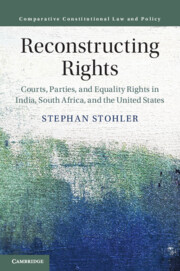 Reconstructing Rights
Reconstructing Rights from Part III - India
Published online by Cambridge University Press: 09 July 2019
The Indian National Congress had opposed reservations (affirmative action) for India's so-called "Other Backward Classes" (OBCs) since drafting India's Constitution. But when a coalition government expanded reservations for OBCs in public employment in 1990, Congress changed its position, potentially bringing the party into conflict with the judges it had previously appointed. But this conflict never occurred. Instead, Congress officials subsequently worked with aligned justices to develop a new doctrinal framework governing reservations in employment. When these justices adopted divergent positions, however, Congress frequently overruled them with constitutional amendments. Unlike the American case, however, India's Supreme Court subsequently reviewed these amendments under the basic structure doctrine, affording them the opportunity to exercise a final say. But, in each instance, these aligned justices capitulated while nonetheless preserving a voice in important constitutional deliberations, which is consistent with the book's argument.
To save this book to your Kindle, first ensure [email protected] is added to your Approved Personal Document E-mail List under your Personal Document Settings on the Manage Your Content and Devices page of your Amazon account. Then enter the ‘name’ part of your Kindle email address below. Find out more about saving to your Kindle.
Note you can select to save to either the @free.kindle.com or @kindle.com variations. ‘@free.kindle.com’ emails are free but can only be saved to your device when it is connected to wi-fi. ‘@kindle.com’ emails can be delivered even when you are not connected to wi-fi, but note that service fees apply.
Find out more about the Kindle Personal Document Service.
To save content items to your account, please confirm that you agree to abide by our usage policies. If this is the first time you use this feature, you will be asked to authorise Cambridge Core to connect with your account. Find out more about saving content to Dropbox.
To save content items to your account, please confirm that you agree to abide by our usage policies. If this is the first time you use this feature, you will be asked to authorise Cambridge Core to connect with your account. Find out more about saving content to Google Drive.